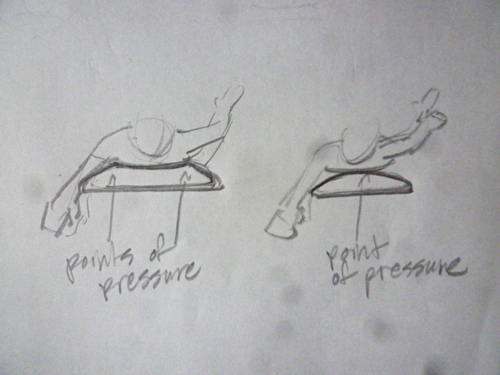
photo by ryo-shimizu.com |
Ben Wei
1976.4.1生まれ。
サーフボードのシェイパー歴20年。カボ サン ルーカスでスタートし、
メキシコ、カリフォルニアのオーシャンサイドでキャリアを積む。
現在は千葉から、1999年より続ける自身のブランド『5050 Waveskates』を展開し、
日々新たなボードデザインを探求している。
エクスクルーシブモデルとしてLazyBoySkillの"Sex Machine, and CoreFighter"、
Zburhの"Waveskate"、"Upload"をシェイプ。8年間Gravity Skateboards teamに所属。
プロサーフチームのライダーの田中英義、森大樹、田嶋鉄平、加藤嵐、Zucchoらと共に、
サーフクロストレーニング用のスケートボード"Twist"をスタート。
音楽マニアで、"Jackson884"というバンドのトラックメーカー。
KORGの新しいVolca Synthesizersのプロモーションビデオも手掛ける。
スポンサー : Moon Jelly Wetsuits, INSP Clothing, GreenFix Wax, FCS,
Gorilla Grip,
Canvas Shoes, KORG, Yamaha Motors Japan, and Skull Candy. |
| 1回目 |
2013/10/2 |
『Choosing the right board for you』 |
| 2回目 |
2013/10/16 |
『Choosing the right board for you 2』 |
| 3回目 |
2013/11/6 |
『Board construction options』 |
| 4回目 |
2013/11/20 |
『Board Rhythm, matching your board to music
(Surfing through a musical perspective).』 |
|
『Choosing the right board for you 2 (正しいボードのチョイス その2)』
前回のコラムで、ボードデザインは、
きみのサーフィンに様々な効果と結果を及ぼす、ということについて書いた。
今回は、もう少し深く掘り下げて、さらにいくつか特徴について話をしようと思う。
ラウンドノーズ VS ポイントノーズ

僕たちの多く(特に自分のように30歳以上の人)は、
より簡単にパドリングでき、より早くテイクオフできることを望んでいる。
ラウンドノーズは、胸の下辺り(パドリングする時に最も重心がかかる位置)をボリュームアップさせることで、
よりスムースなグライドができる。
ポイントノーズは、ホレてハードな波でバーティカル・ターンをするためにデザインされている。
自分により近い水面をカットでき、ターンでフェイスを登って行く時に、ボードが邪魔にならない。
しかし、そんなスティープな波でサーフィンする訳ではなく、
日常的な波や、ハイタイドの厚いコンディション時にサーフィンする上で、
ポイントノーズ、ハイロッカーは水をプッシュし、パドリングのスピードをダウンさせてしまう。
日常のコンディションで、きみがプロサーファーのレベルでなければ、
ラウンドノーズは全く問題なく、ポイントノーズでは乗れないような波でもグライドできるだろう。
次はデッキシェイプについて話そう。

ドームデッキ
トラッドなデザインで、ボードの中心が浮体の重心であり、
ターンする時にレールは沈みやすく、サイドは傾きやすくなっている。
きみの足に完全にフィットしないかもしれないが、時間が経てば足のくぼみがボードにできるはずだ。
コンケーブデッキ
僕は、15年間コンケーブデッキをデザインし、テストし、そして乗って、たくさんの収穫を得た。
近年、多くのトップシェイパーたちが、彼らのラインの中にコンケーブデッキを取り入れてきている。
ケリー・スレーターは様々な種類のコンケーブデッキに乗っていて、
ブルース・アイアンは今もコンケーブデッキに乗っている。
他のプロたちも良さを感じ、乗り始めている。
現代のスケートボードの100%がコンケーブデッキであることに示されるように、
このデザインはデッキの輪郭をしっかりとらえ、足できっちり捉えられることによって、
フィット感とコントロール性に非常に優れている。
ボードの”上”に立っているというより、むしろ、ボードの”中”に立っているかのようなフィーリングだ。
つま先と踵をコンケーブの高いポイントまで持っていくと、
レールtoレールの動きへの感触をつかみやすくなる。
コンケーブデッキに乗ると、ボリュームがレールに押し出され、ボードはより安定する。
だが、それは両サイドが簡単に傾くということではない。
効率的且つ、バランスよくパドリングができ、ボードに触れている胸の部分をしっかり支えることができる。
エアリアルをする場合、コンケーブデッキは、空中でよりボードをコントロールし易くする。
そしてグラブすることは、ただ単にボードを支えるだけでなく、かっこいいマニューバーのひとつだ。
ドームデッキで、足を横から横に少し移動させると、ボードとの接点を失ってしまう。
コンケーブデッキは、足を横から横に少し移動させると、ボードとの接点を得ることができる。
僕らはサーファーとして、現代に生きていることが非常にラッキーだと思う。
なぜなら、幅広く、バラエティーに富んだデザインの中からサーフボードを選ぶことができ、
そして異なる要素をミックスさせれば、さらにニーズに合うものを作れる。
そうしたボードに乗ることによって、自分が想像する以上に、上手にサーフィンができるのだから。
僕は、きみがサーフィンの新しい楽しみ方を、見つけてくれることを願っているよ。
読んでくれてありがとう。
ベン・ウェイ
--------------------------------------------------------------------------------------------------------------
Choosing the right board for you 2
I mentioned in the last article, the effect and results that different board features have on your surfing.
This time, I want to dig in a little deeper, and mention some more advanced features that were left out.
Round nose vs. Pointed nose
Many of us (especially if you're over 30 years old like me) are looking for easier paddling, and earlier takeoff.
A round nose provides that, by putting more volume up under your chest, (the place where your weight is most concentrated while paddling, and during takeoff), and more surface for smoother glide.
For vertical turns in steep surf, a pointed nose will allow you to cut more closely to the face, and won't get in the way while climbing up the face.
However for everyday surf, and high tide conditions, a pointed, rockered, nose will push water, and slow down paddling, when not dropping into a steeper face.
For everyday conditions, and for less than pro level surfers, a round nose won't get in the way, and will allow you to glide into waves that a pointed nose can't get into.
The next thing I want to cover is deck shape.
Dome Deck
This traditional design, puts the majority of flotation in the center of the board, making it easier to sink the rails and tilt from side to side, while turning.
It doesn't fit your foot perfectly, but the board dent to form to your foot after time.
Concave Deck
I have designed, tested, and ridden Concave Deck for over 15 years, and have found a lot of benefits.
In recent years, many top shapers have started to produce a concave deck design in their line of boards, Kelly Slater has ridden many versions of concave deck, Bruce Irons now rides concave deck, and a number of other pros are starting to discover the benefits.
Concave Deck, just as in 100% of modern skateboards, provides excellent traction, and control, by cradling your foot inside of the contour of the deck, more like standing (in) the board, than standing (on) the board.
By having your toes and heels elevated the high points of the concave, you get increased pressure rail to rail.
On a board with concave deck, the volume is pushed out towards the rail, so the board becomes more stable, in that it doesn't tilt side to side easily, which makes paddling more balanced, and efficient, as well as cradling your chest for a more connected to the board feeling.
For aerial surfing, a Concave Deck provides more control over the boards direction in the air, and grabs can be performed as a maneuver, and not just to keep the board under your feet.
On a dome deck, a slight shift of your foot, from side to side, will cause your foot to lose contact with the board.
On a concave deck, s slight shift of your foot from side to side will increase the contact with the board.
We are very lucky as surfers, to live in an age when there is such a wide variety of shapes and features to choose from, and by mixing the different elements together to suit your needs, you will be able to surf better than you had ever imagined.
I hope that you will discover new enjoyment in surfing…
Thank you for reading, Ben Wei
|
